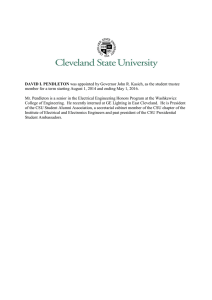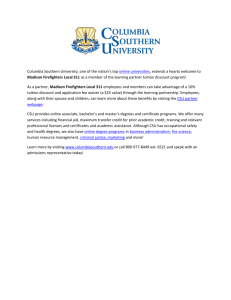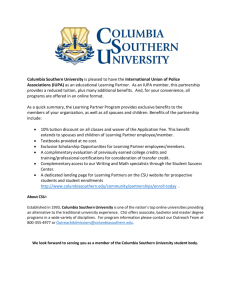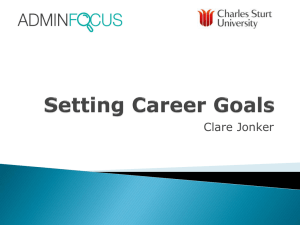iles F Field
advertisement
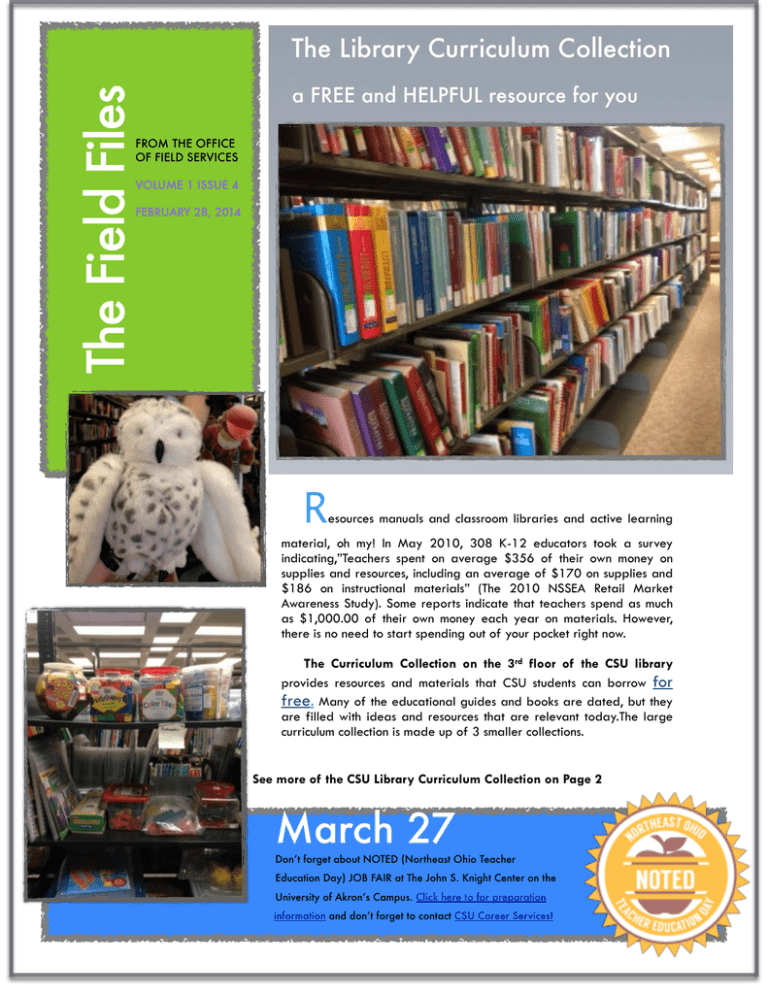
The Field Files The Library Curriculum Collection a FREE and HELPFUL resource for you FROM THE OFFICE OF FIELD SERVICES VOLUME 1 ISSUE 4 FEBRUARY 28, 2014 R esources manuals and classroom libraries and active learning material, oh my! In May 2010, 308 K-12 educators took a survey indicating,”Teachers spent on average $356 of their own money on supplies and resources, including an average of $170 on supplies and $186 on instructional materials” (The 2010 NSSEA Retail Market Awareness Study). Some reports indicate that teachers spend as much as $1,000.00 of their own money each year on materials. However, there is no need to start spending out of your pocket right now. The Curriculum Collection on the 3rd floor of the CSU library provides resources and materials that CSU students can borrow for free. Many of the educational guides and books are dated, but they are filled with ideas and resources that are relevant today.The large curriculum collection is made up of 3 smaller collections. See more of the CSU Library Curriculum Collection on Page 2 March 27 Don’t forget about NOTED (Northeast Ohio Teacher Education Day) JOB FAIR at The John S. Knight Center on the University of Akron’s Campus. Click here to for preparation information and don’t forget to contact CSU Career Services! Collection 3’s Treasures Collection 1: Juvenile books (for the kids) This collection is made up of fictional works and non-fiction books that range in appropriateness from K – 12. These may be checked out to read aloud or use in lesson support. Collection 2: Curriculum Materials (for the teachers) Although this is not common core updated, there are many textbook series available that are as new as 2010. Don’t dismiss a textbook that is not common core aligned. You will still be able to find ideas from the teacher’s resource guides to create a lesson to teach the learning outcomes you plan for Common Core State Standards Borrow a big book for story time or even a unique way to teach literary elements to middle school and high school students Need an idea for a hook? How about quick engagement with a puppet ? This too (depending upon the puppet and the lesson) works for all grades and most content areas. Collection 3: Curriculum Media This is a great place to play around with ideas for Hook, Closure, Differentiation, and engagement. Anything found in the Curriculum Center that is not a book is housed in this part of the Collection. Collection 3 includes items such as: 1) storytelling kits 2) finger puppets 3) science kits 4) flip books 5) corkboards and flannel boards 6) pocket charts All of these items are catalogued and can be viewed online to check for availability. They can be checked out for a 2 week time frame. Think outside for ways that these tools can be used in the classroom. At first, many seem geared toward Early Childhood, but they may be great ways to engage older audiences too. An additional part of the Curriculum Collection is the reference collection. This is the only part of the collection that cannot be checked out. It includes excellent resources such as A to Zoo – this book allows you to look up a subject and find a list of books about that subject. CSU’s library may not have those available, but you can likely find them at a branch of the county library. Other helpful titles include Beyond Picture Books, Books Kids Will Sit Still For, Picture This – a guide to picture books for young adults, and Using Picture Storybooks to Teach Literary Devices: Recommended Books for Children and Young Adults, Get your kinesthetic learners of all ages to participate and activate their brains with a variety of available charts. Just add index cards! Engaged Learning at All Levels ......The longer you are in education,the more you’ll hear conversation around the topic of, “What happens in 5th and 6th grade that makes kids dislike school?” Maybe it is that recess tends to disappear and traditional “direct instruction” tends to monopolize. Perhaps a way to keep kids intrigued is to make learning interactive and to pull from the same techniques used in younger grades. Check out these links for some ideas. PBS newshour extra lesson plans for high school creative writing lesson ideas that can be adapted for all levels Borrow a science theme box, talking microscope, heart model, or other manipulatives;think outside of the box and your students will too! The Art of Storytelling for reading, writing, and listening and speaking standards - adaptable for all ages 55 word short stories for introduction of short story units - adaptable for many grade levels Reminder!! edTPA Workdays OFS office open and staff available Computer labs open and tech help available Saturday, March 1: 9 - 1 Saturday, March 8: 11 - 3 Selecting the Right edTPA Video Clip Step 1: Look for evidence of respect and rapport. How do you show respect? How do they show respect? Make sure you cite examples in your commentary. Step 2: What evidence do you have that the learning environment challenges students? Make sure it is in your video! How is an environment conducive to learning different from an environment focused on managing behaviors? Make sure your video shows that supportive, learning environment. Step 3: How are “engaged” students different from just “participating” students? What evidence can your video provide to show how active the learning process is in your classroom? Think about those verbs from Bloom’s Taxonomy that are high level and involve create and evaluate. Step 4: Evaluators want to see how you are deepening student understanding. Even though direct instruction is an important part of learning, would a video of you delivering a mini-lecture really show deepening student understanding? What kinds of evidence of interaction that shows students building one bit of knowledge on top of another can you find in your video clip? Check out information about Costa’s Levels of Questioning if you need help. Step 5: Educational researcher John Hattie studies the difference between novice teachers, effective teachers, and expert teachers. (click here to read his research) A big difference is that expert teachers ask how they can improve their teaching and how they can change their teaching to increase student progress. Remember that even though you want everything about your lessons to be perfect, research supports that the best way to become an expert teacher is to reflect upon teaching to make changes and improvements. In Task 2, you do need to analyze your own effectiveness. Looking at what did not work and how you can do it better next time is an important part of your growth as a teacher. Step 6: Go back to your rubrics! This is a not an all inclusive guide. Each licensure area has specific requirements that connect to subjectspecific pedagogy. Ask yourself, “Does my video clip fulfill this requirement?” Did You Know… Cleveland Metropolitan Schools mid-year reviews Ohio Achievement Tests Window extended Benjamin Franklin Elementary Cafeteria Makeover Euclid Students Honored in MLK speech contest North Royalton Students Honored at Diversity Luncheon Lorain schools building projects staying on budget Kasich discusses education changes in State of the State speech …Talking Points for Networking Time to Start Your Job Search Visit ODE education job search to start looking for job openings Don’t forget about NOTED Making Good Choices: A Support Guide for edTPA Candidates Visit CSU Career Services Call Career Services at (216)687 2233 Set-up a LinkedIn Education Week Top School Jobs Virtual Education Job Fair March 6
